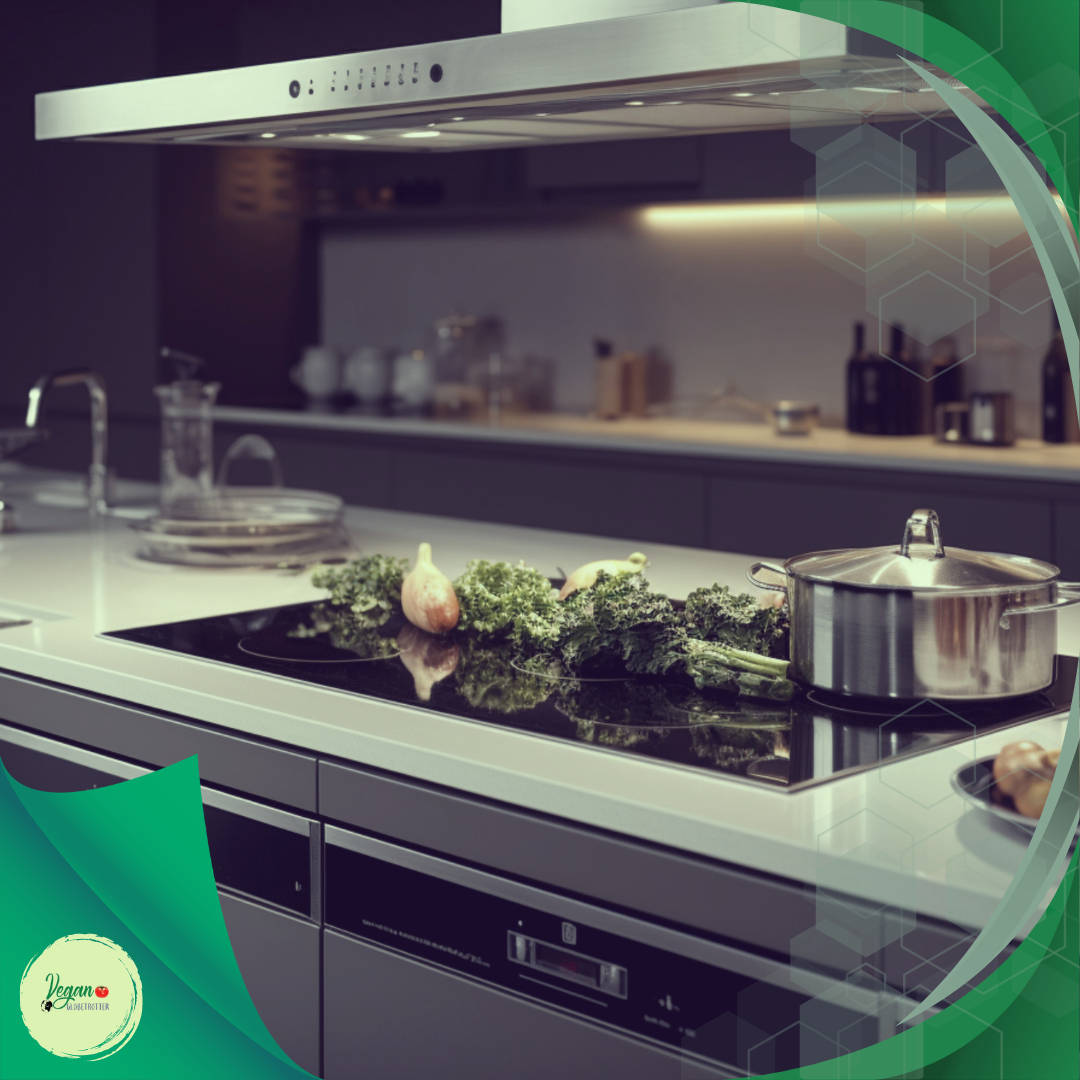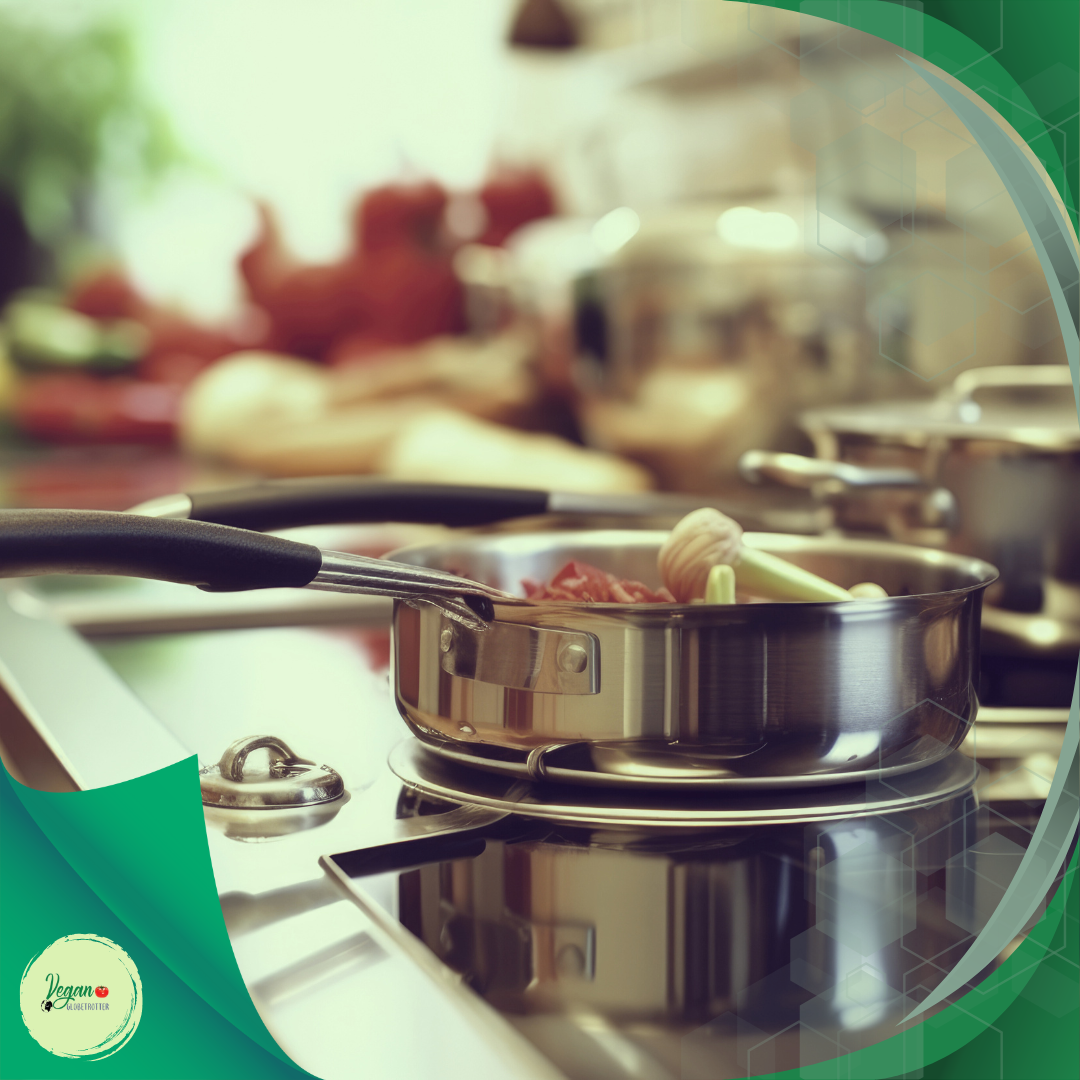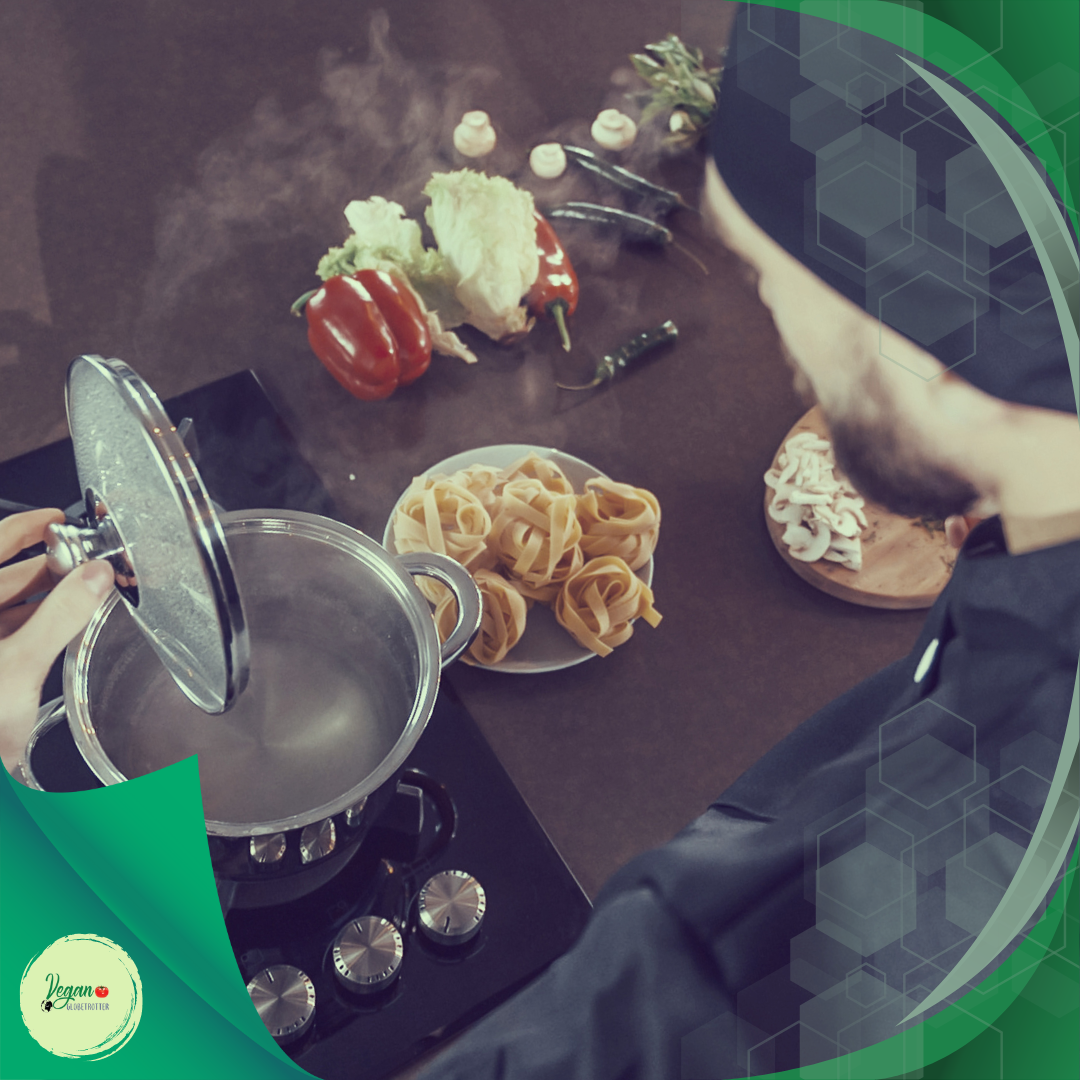Vegan Globetrotter is supported by our audience. When you purchase through one of our links, we may earn a small affiliate commission. As an Amazon Associate I earn from qualifying purchases. Your cost is not affected.
==================
Have you ever pondered over the intricate dance of tasks that unfold in a bustling commercial kitchen? As someone who has always been fascinated by the culinary world, I’ve often found myself drawn to the heart of the action, where chefs orchestrate a symphony of flavors amidst the clatter of pots and pans.
In my quest to delve deeper into the realm of kitchen efficiency and safety, I stumbled upon a transformative solution that’s been making waves in commercial kitchens worldwide: induction cooking. Intrigued by its promise of enhanced safety and efficiency, I embarked on a journey of research to uncover the myriad benefits this technology brings to the bustling environment of professional kitchens.

Together, let’s see the world of induction cooking and its profound impact on kitchen safety, efficiency, and overall culinary experience. From its ingenious design to its practical applications in real-world scenarios, we’ll uncover how induction cooking is revolutionizing the way chefs work while mitigating risks and ensuring a safer environment for all.
So grab your aprons and let’s dive into the fascinating realm of induction cooking in commercial kitchens. It’s time to turn up the heat and discover how this innovative technology is reshaping the culinary landscape, one kitchen at a time.

Safety of Induction Cooking in Commercial Kitchens: Enhancing Kitchen Efficiency and Mitigating Fire Risks
In commercial kitchens, the orchestration of numerous culinary tasks unfolds swiftly and continuously. In this environment, safely managing the heat source is crucial to both product quality and the wellbeing of staff.

Induction cooking has emerged as a transformative solution that responds to the safety challenges traditional cooking methods present. This technology employs an electromagnetic field to directly heat pots and pans, eliminating the need for open flames or hot heating elements.
The meticulous design of induction cooktops brings a confluence of safety enhancements that are particularly beneficial in the high-pressure environment of commercial kitchens. For instance, the surface surrounding the cookware remains comparatively cool to the touch during the cooking process.
Moreover, the auto-off feature inherent to induction cooking units provides an additional layer of safety. The cooktop automatically shuts off when cookware is removed, thereby averting potential hazards associated with unattended heat sources.

Major Points
- Induction cooking reduces burns and fire risks in kitchens.
- Surrounding surfaces stay cool, lowering the chances of heat-related accidents.
- Auto-off features on induction cooktops enhance kitchen safety.
Overview of Induction Cooking Technology
Induction cooking represents a significant advancement in kitchen technology, especially for commercial use. It operates on the principle of electromagnetic induction, which involves the generation of an electromagnetic field by a copper coil located beneath the cooking surface.
When induction-compatible cookware, such as those made with ferrous materials, is placed on the cooktop, the electromagnetic field induces electrical currents in the cookware, which in turn produce heat.

Key Attributes of Induction Cooking:
- Efficient Heat Transfer: The direct heating of the cookware results in rapid heating, reducing preparation time and enhancing kitchen throughput.
- Precise Temperature Control: Temperature adjustments are almost instantaneous, providing chefs with exacting control over the cooking process.
- Safety Enhancements: Since the cooktop itself does not get as hot as traditional burners, there is a reduced risk of burns, and the potential for accidental fires is minimized.
- Ease of Cleaning: The flat cooking surface is not heated directly, allowing for easier cleaning as food does not burn onto the cooktop.
Technical Components:
- Copper Coil: Generates an electromagnetic field.
- Glass-ceramic Surface: Provides a durable and easy-to-clean cooking area.
- Induction Cookware: Must contain ferrous material to work with the induction technology.
This technology contrasts sharply with conventional cooking methods like gas or electric stoves, where heat is transferred through thermal conduction, often less efficiently and with fewer safety benefits.
Comparative Analysis of Safety Features
When comparing the safety features of induction cooking to traditional cooking methods in commercial kitchens, several key differences are notable. Induction technology enhances safety by eliminating open flames and reducing the chances of fires.

Unlike gas ranges, which operate using combustible fuel, induction cooktops only generate heat where the cookware sits, mitigating the risk of burns that can occur from an open flame or hot surfaces.
Induction cooktops also have a significant advantage in terms of temperature control. They offer precise and immediate temperature adjustments, reducing the likelihood of overheating and corresponding kitchen accidents. This level of control is beneficial in a high-paced commercial kitchen environment, where attention can be split across multiple tasks.
| Feature | Induction Cooking | Gas/Electric Cooking |
|---|---|---|
| Open Flame | None | Present |
| Surface Temperature | Lower | Higher |
| Temperature Control | Precise | Variable |
| Cookware Detection | Yes | No |
Lastly, as induction cooktops do not heat up as much as their gas or electric counterparts, they contribute to a cooler kitchen environment. This reduction in ambient temperature can minimize the stress on kitchen ventilation systems and prevent the exacerbation of any small kitchen mishaps into larger safety hazards.
Advantages of Induction Cooking in Commercial Settings
Commercial kitchens benefit from induction technology through increased safety and improved operational efficiency. The following are pivotal advantages detailed in subsections.

Reduced Fire Risk
Induction cooking in commercial settings significantly diminishes the risk of fires. Since induction units utilize electromagnetic energy to heat pans directly, there’s no open flame or hot coil that could ignite spills or splatters. According to an article on SilverChef, this technology can lead to a safer kitchen environment.
Lower Surface Temperatures
Surface temperatures remain lower with induction cooktops, as they only heat the cookware, leaving the cooktop itself cooler. This reduces burn hazards and contributes to a safer working environment. As highlighted on Empire Supplies Online, the cooktop is cool to the touch almost immediately after the cookware is removed.
Improved Air Quality
Induction cooking offers cleaner air quality since there are no combustion gases, unlike gas cooktops that release pollutants into the kitchen environment. This leads not only to a more pleasant working atmosphere but also supports health regulations focused on indoor air quality, as indicated by information found on Hatco Corporation.
Enhanced Emergency Responsiveness
In commercial kitchens, emergencies must be addressed quickly. Induction cooktops can be instantly turned off, immediately ceasing heat production. The precision and quick responsiveness of induction technology provide chefs with immediate control over cooking conditions, significantly enhancing safety during emergencies.
Case Studies: Induction Cooking in Commercial Kitchens
In recent years, a number of commercial kitchens have transitioned to induction cooking systems, and these case studies highlight the safety benefits of such a move.

Improved Working Environment: A significant benefit observed is the reduction in ambient heat. Unlike traditional gas ranges, induction cooktops generate heat directly in the cookware, leaving the kitchen cooler and more comfortable for staff, as confirmed by the Foodservice Equipment & Supplies magazine.
Reduced Fire Risk: Induction cooktops only heat when specific cookware is placed on them, greatly diminishing fire hazards. This has been exemplified in several high-volume restaurants, which noted a decrease in kitchen fires after replacing their gas ranges with induction units.
Precise Temperature Control: Chefs have praised induction cooktops for their precise control, which translates into lower risks of burns and overcooked food, as seen in commercial kitchen experiences.
| Case Study | Benefit | Details |
|---|---|---|
| High-Traffic Diner | Efficiency & Safety | Shift to induction resulted in faster service with minimal accidents. |
| Gourmet Restaurant | Precision & Reliability | Induction provided consistent temperatures, reducing food waste. |
Implementation Strategies
When incorporating induction cooking into a commercial kitchen, it is vital to consider the design layout, provide comprehensive training for staff, and establish protocols for equipment maintenance.

Kitchen Design Considerations
A kitchen’s layout must integrate induction cooking stations in a manner that optimizes space and enhances workflow.
Considerations include adequate electrical infrastructure, as induction cooktops require significant electrical power.
Space planning should ensure there’s enough room for induction equipment, which may have different spacing requirements than traditional gas ranges.
Accessibility and the potential to retrofit existing spaces to accommodate induction technology should also be evaluated.
Staff Training and Education
The shift to induction cooking requires a knowledgeable team adept at leveraging the new technology.
Staff should receive specific training on the operational nuances of induction cooktops. This includes the importance of using compatible cookware and understanding precise temperature controls.
Educational programs must cover safety practices and the energy efficiency benefits of induction cooking to foster buy-in from the team.
Maintenance and Upkeep
Induction cooktops demand routine maintenance to perform at their best.
A calendar for regular cleaning and inspection should be developed to handle wear and tear and prevent downtime.
In addition to routine care, staff must be trained to recognize common issues like electromagnetic coil failures. They should also be familiar with the procedure for reporting problems.
A list of recommended service providers for regular maintenance and emergency repairs should be readily accessible.
Regulatory Compliance and Standards
Induction cooking technology in commercial kitchens must adhere to specific regulatory compliance and standards.
These standards are designed to ensure that induction cooktops are not only efficient but also safe for both the cooking environment and the personnel using them.

Certifications such as UL and NSF are essential for induction equipment. They indicate that the products have been tested and meet certain safety standards.
Compliance with these certifications helps prevent incidents related to electrical hazards or contaminants that could risk the safety of food and kitchen staff.
In addition, commercial kitchens must follow local building codes and health regulations, which often encompass the installation and operation of induction cooking systems.
For instance, they may include particular requirements for ventilation systems, even though induction cooktops produce less ambient heat than traditional gas or electric ranges.
Local Regulations vary, with certain areas requiring specific measures for energy efficiency and waste management.
Kitchen owners should be particularly mindful of these regulations, as non-compliance can result in fines or operational disruptions.

Here is a brief overview of what a commercial kitchen must consider for regulatory compliance with induction cooking systems:
- Certifications: Necessary for product safety and quality assurance. Examples include:
- UL (Underwriters Laboratories)
- NSF (National Sanitation Foundation)
- Building Codes: Vary by region and can affect installation practices.
- Health Regulations: Address sanitation and food safety requirements.
- Ventilation Guidelines: Less stringent but still necessary for induction cooking to ensure proper air quality.
For more detailed guidance, commercial kitchen operators can refer to resources such as Understanding Certifications, Regulations, and Codes in Commercial Kitchens which provide insights into dealing with the nuances of these requirements.
Economic Considerations of Induction Cooking
When examining the economic impact of induction cooking in commercial kitchens, it’s crucial to evaluate both the initial investment and the long-term operational costs.

Induction technology typically demands a higher upfront cost compared to traditional gas or electric stoves. However, this is often counterbalanced by the technology’s energy efficiency and lower operating costs.
Energy Efficiency: Induction cooktops are highly energy-efficient, converting up to 90% of energy directly to heat, as opposed to gas which converts a lower percentage.
This high level of efficiency can lead to considerable energy savings over time.
Cooking Speed: A faster cooking time can equate to a lower energy usage.
For example, a 3600-watt induction cooktop can boil water in nearly half the time of an electric range.
This can contribute to a higher turnover rate and more meals prepared within the same timeframe, thus improving kitchen throughput.
Cost Comparison:
| Feature | Induction | Gas | Electric |
|---|---|---|---|
| Initial Cost | High | Medium | Low |
| Energy Efficiency | High | Low | Medium |
| Operational Cost | Low | High | High |
| Heat-Up Time | Fast | Moderate | Slow |
Durability and Maintenance: Induction cooktops are also lauded for their durability and ease of maintenance.
Because the cooking surface remains cooler, they are less susceptible to wear and damage that can result from high heat.
Furthermore, the smooth and flat surface is easy to clean, which helps maintain appearance and functionality, thereby potentially reducing maintenance costs.
Future Trends in Commercial Kitchen Safety
The landscape of commercial kitchen safety is rapidly evolving, with a significant push towards technologies that minimize risks and enhance safety protocols.
Induction cooking has surfaced as a prominent player in this transformation, offering a safer work environment for chefs and kitchen staff.

Induction technology presents several key safety advantages:
- Reduced Burn Risk: Surfaces stay cooler, substantially reducing the likelihood of burns compared to traditional gas and electric ranges.
- Fire Safety: With no open flame, induction cooktops lower the risk of fires, a major safety concern in commercial kitchens.
- Air Quality: Induction units emit no combustion byproducts, which translates to better air quality by eliminating pollutants associated with gas cooking.
Looking ahead, induction cooking will likely become more prevalent as safety regulations tighten, and businesses prioritize employee welfare.
Enhanced safety features are also anticipated, such as automatic shutoff mechanisms and more sensitive temperature controls, helping to prevent overheating and further reduce accidents.
The integration of smart technology with induction systems could provide real-time feedback and monitoring, alerting staff to potential hazards, and improving overall safety standards.
Tools like digital checklists and maintenance reminders may assist in ensuring that equipment adheres to safety protocols consistently.
Finally, as sustainability becomes intertwined with safety, induction cooking positions itself as an attractive solution for future-proofing commercial kitchens against both safety and environmental concerns, as emphasized by the emphasis on kitchen electrification to avoid reliance on fossil fuels.
| Key Advancements | Impact on Safety |
|---|---|
| Reduced Surfaces Temperature | Lowers burn incidents |
| Absence of Open Flame | Decreases fire hazard |
| Better Indoor Air Quality | Healthier environment |
Safety of Induction Cooking: Embracing Efficiency and Enhancing Kitchen Safety
As we draw the curtain on our exploration of induction cooking in commercial kitchens, it’s clear that the journey has been nothing short of enlightening. Together, we’ve uncovered the myriad ways in which this innovative technology has transformed the culinary landscape, enhancing both safety and efficiency along the way.

From the meticulous design of induction cooktops to the tangible benefits experienced by chefs in high-pressure environments, the advantages are undeniable. We’ve seen how induction cooking reduces burns and fire risks, keeps surrounding surfaces cool, and offers precise temperature control—all factors that contribute to a safer and more streamlined kitchen experience.
As I reflect on our journey together, I can’t help but feel a sense of excitement for the future of commercial kitchens. With induction cooking leading the charge in safety and efficiency, the possibilities are truly endless.

So, to all my fellow kitchen enthusiasts, I hope this exploration has left you inspired and informed. As we continue to innovate and adapt in the culinary world, let’s embrace the advancements that make our kitchens safer, more efficient, and ultimately, more enjoyable to work in.
Here’s to many more delicious adventures in the kitchen!
Frequently Asked Questions
This section addresses common safety-related inquiries regarding induction cooking in commercial settings, detailing how the technology enhances protection against common kitchen hazards.
Why is induction cooking considered safer in commercial kitchens compared to traditional methods?
Induction cooking is perceived as safer in commercial kitchens because it eliminates open flames and reduces the heat on cooking surfaces. This technology only heats the cookware, significantly lowering the chance of burns from the cooktop itself.
What specific safety features do induction cooktops offer for commercial kitchen use?
Commercial induction cooktops often incorporate multiple temperature sensors and quiet scroll fans, providing precise control over cooking temperatures. These features help prevent overheating and reduce fire risks.
How does induction cooking technology minimize the risk of burns and fires in commercial settings?
Induction cooking minimizes the risk of burns and fires by targeting heat directly to the cookware while leaving the surrounding area cooler. This approach lessens the likelihood of burn accidents and prevents common fire risks associated with traditional cooktops.
In what ways can induction cookware contribute to enhanced kitchen safety in a professional environment?
Induction cookware is designed to work with the electromagnetic field produced by the cooktop, which means the cookware itself becomes the heating element. This design results in less residual heat in the kitchen environment, contributing to a safer working space for chefs and kitchen staff.
What are some safety precautions that should be taken when using induction cookers in a commercial kitchen?
When using induction cookers, all cookware should be induction-compatible to ensure proper functioning.
It’s also important to keep magnetic items away from the cooktop to avoid unwanted heating and maintain a clean surface to prevent accidents.
Are there any safety certifications or standards for induction ranges that commercial kitchens should be aware of?
Yes, commercial kitchens should look for induction ranges that meet safety certifications or standards, such as those by Underwriters Laboratories (UL) or the National Sanitation Foundation (NSF).
These certifications ensure that the equipment has passed rigorous testing for safe operation in a commercial setting.



Don't miss out
when new recipes and information are added!
Join our newsletter for free recipes,
healthy living inspiration, and special offers
You have Successfully Subscribed!